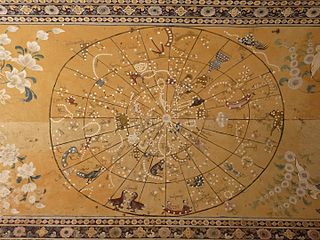
The zodiac is a belt-shaped region of the sky that extends approximately 8° north or south of the ecliptic, the apparent path of the Sun across the celestial sphere over the course of the year. The paths of the Moon and visible planets are within the belt of the zodiac.

Traditional Chinese astronomy has a system of dividing the celestial sphere into asterisms or constellations, known as "officials".

Chinese astrology is based on the traditional astronomy and calendars. Chinese astrology came to flourish during the Han Dynasty.

Astronomical symbols are abstract pictorial symbols used to represent astronomical objects, theoretical constructs and observational events in European astronomy. The earliest forms of these symbols appear in Greek papyrus texts of late antiquity. The Byzantine codices in which many Greek papyrus texts were preserved continued and extended the inventory of astronomical symbols. New symbols have been invented to represent many planets and minor planets discovered in the 18th to the 21st centuries.
Keiko Han is a Japanese actress, voice actress and western astrologer. She sang the theme songs in productions such as Story of the Alps: My Annette and Kazoku Robinson Hyōryūki Fushigi na Shima no Furōne. Han is a fortune teller of western horoscopes. She wrote books on the subject. She is employed by talent agency Never Land Arts, and was previously affiliated with Aoni Production & 81 Produce.

Pisces (♓︎) is the twelfth and final astrological sign in the zodiac. It is a negative, mutable sign. It spans 330° to 360° of celestial longitude. Under the tropical zodiac, the sun transits this area between February 19 and March 20. In classical interpretations, the symbol of the fish is derived from the ichthyocentaurs, who aided Aphrodite when she was born from the sea.

In Japanese language, Ryakuji are colloquial simplifications of kanji.
Often called lunar mansion, a lunar station or lunar house is a segment of the ecliptic through which the Moon passes in its orbit around the Earth. The concept was used by several ancient cultures as part of their calendrical system.
Akie Yoshizawa is a former Japanese idol, singer and actress in the 1980s. She made her debut in 1985, simultaneously selected as a member of Jpop female band Onyanko Club and as an actress in the TV series Sukeban Deka II as one of the three main parts. This led to appearances by her band in two episodes. She released a few solo discs before she retired, and married in 1996.

The Burmese zodiac is the traditional Burmese system of astronomy and astrology. While it is still an important component of the Burmese calendar, today, the zodiac is closely identified with Burmese astrology, called Bedin (ဗေဒင်). Largely derived from Hindu astronomy and Vedic astrology, the Burmese zodiac consists of not only the same 12 signs of the Western zodiac but also 27 lunar mansions of the month and eight weekday signs.

The Chinese zodiac is a traditional classification scheme based on the lunar calendar that assigns an animal and its reputed attributes to each year in a repeating twelve-year cycle. Originating from China, the zodiac and its variations remain popular in many East Asian and Southeast Asian countries, such as Japan, South Korea, Vietnam, Cambodia, Singapore, Nepal, Bhutan and Thailand.

Ophiuchus has sometimes been suggested in sidereal astrology as a 13th astrological sign in addition to the 12 signs of the tropical zodiac. The constellation Ophiuchus, as defined by the 1930 International Astronomical Union's constellation boundaries, is situated behind the sun from November 29 to December 18.
Yoshimasa Hosoya is a Japanese voice actor and narrator.
Hiroko Okabe, known professionally as Yūka, is a Japanese actress, presenter, and former gravure idol. She is known for playing the lead role in NHK's drama Honjitsu wa Taian Nari and presenting the TBS variety show Ōsama no Brunch. From 1999 to 2001, she received the Golden Arrow Award every year. In 2003, she was given both a Golden Graph Award and the Japan Academy Prize for Best Newcomer.
Ryusei Yokohama is a Japanese actor, model, and former singer. He is affiliated with Stardust Promotion. He is best known for playing the role of the pink-haired Yuri Kyohei in the 2019 romantic comedy drama Hajimete Koi wo Shita Hi ni Yomu Hanashi as well as Hikari Nonomura in the 2014 Super Sentai TV series Ressha Sentai ToQger.

Mei Nagano is a Japanese actress. Amongst her film and television credits are Rinko in the film My Love Story!, Suzume Yosano in the film Daytime Shooting Star, and Suzume Nireno in the 98th NHK asadora Hanbun, Aoi.

Star Twinkle Pretty Cure is a Japanese magical girl anime series by Toei Animation. It is the sixteenth installment in the Pretty Cure franchise, and the last series released in the Heisei period. and the sixteenth installment of the franchise, featuring the fourteenth generation of Cures. It is directed by Hiroaki Miyamoto and written by Isao Murayama. The series aired on all ANN stations in Japan from February 3, 2019, to January 26, 2020, succeeding HUG! PreCure in its initial time slot. It was then succeeded by Healin' Good Pretty Cure on February 2, 2020. The series' main topics are imagination and diversity, with outer space, constellations and singing being the Cures' main motifs.
Rasta Kido known as Rasta (良星) is a Japanese kickboxer. A professional competitor since 2013, Kido is the former BigBang Super Bantamweight titlist and one-time RISE Bantamweight title challenger. He is a highly considered Flyweight fighter by Combat Press.










